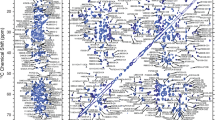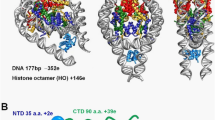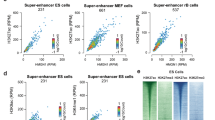ABSTRACT
Using atomic force microscopy (AFM), the dynamic process of the in vitro nucleosome reconstitution followed by slow dilution from high salt to low salt was visualized. Data showed that the histone octamers were dissociated from DNA at 1M NaCl. When the salt concentration was slowly reduced to 650 mM and 300 mM, the core histones bound to the naked DNA gradually. Once the salt concentration was reduced to 50 mM the classic “beads-on-a-string” structure was clearly visualized. Furthermore, using the technique of the in vitro reconstitution of nucleosome, the mono- and di- nucleosomes were assembled in vitro with both HS2core (-10681 to -10970 bp) and NCR2 (-372 to -194 bp) DNA sequences in the 5′flanking sequence of human b-globin gene. Data revealed that HMG 1/2 and HMG14/17 proteins binding to both DNA sequences are changeable following the assembly and disassembly of nucleosomes. We suggest that the changeable binding patterns of HMG 14/17 and HMG1/2 proteins with these regulatory elements may be critical in the process of nucleosome assembly, recruitment of chromatin-modifying activities, and the regulation of human b-globin gene expression.
Similar content being viewed by others
Log in or create a free account to read this content
Gain free access to this article, as well as selected content from this journal and more on nature.com
or
Abbreviations
- HMG:
-
High Mobility Group proteins
- AFM:
-
Atomic Force Microscopy
- HS2 core:
-
the core DNA sequence of DNaseI HyperSensitive site 2
- NCR2:
-
Negative Control Region 2
- EMSA:
-
Electrophoresis Mobility Shift Assay
References
Qian RL, Liu ZX, Zhou MY, Xie HY, Jiang C, Yan ZJ, Li MQ, Zhang Y, and Hu J . Visualization of chromatin folding patterns in chicken erythrocytes by atomic force microscopy (AFM). Cell Research 1997; 7:143–50.
Zhao H, Zhang Y, Zhang SB, Jiang C, He QY, Li MQ, and Qian RL . The structure of the nucleosome core particle of chromatin in chicken erythrocytes visualized by using atomic force microscopy. Cell Research 1999; 9:255–60.
Berg, PE, Williams DM, Qian RL, Cohen Rb, Cao SX, Mittelman M, and Schechter AN . A common protein binds to two silencers 5′to the human b-globin gene. Nucleic Acids Res 1989; 17:8833–52.
Lutter LC . Kinetic analysis of deoxyribonuclease I cleavages in the nucleosome core: evidence for a DNA superhelix. J Mol Biol 1978; 124:391–420.
Drew HR and Calladine CR . Sequence-specific positioning of core histones on an 860 base-pair DNA, experiment and theory. J Mol Biol 1987; 195:143–73.
Rhodes D and Laskey RA . Assembly of nucleosomes and chromatin in vitro. Methods Enzymol 1989; 170:575–85.
Goodwin GH and Johns EW .Isolation and characterization of two calf-thymus chromotin non-histone proteins with high contents of acidic and basic amino acids. Eur J Biochem 1973; 40:215–9.
Bradford MM . A rapid and sensitive method for the quantitation of microgram quantities of protein utilizing the principle of protein-dye binding. Anal Biochem 1976; 72:248–54.
Yan ZJ, Chen YD, and Qian RL . Developmental stage-specific factors in the mouse hematopoietic tissues binding to the 5′-flanking cis-acting element of human e-globin gene. Chinese Science Bulletin 1995; 40:778–83.
Kornberg RD . Structure of chromatin. Annu Rev Biochem 1977; 46:931–54.
Luger K, Mader AW, Richmond RK, Sargent DF, and Richmond TJ . Crystal structure of the nucleosome core particle at 2.8 ? resolution. Nature 1997; 389:251–60.
Allen MJ, Dong XF, O'Neill TE, Yau P, Kowalczykowski SC, Gatewood J, Balhorn R and Bradbury EM . Atomic force microscope measurement of nucleosome cores assembled along defined DNA sequences. Biochemistry 1993; 32:8390–6.
Leuba SH, Bustamante C, Van holde K and Zlatanova J . Linker histone tails and N-tails of histone H3 are redundant: Scanning force microscopy studies of reconstituted fibers. Biophys J 1998; 74:2830–9.
Bustin M . and Reeves R. High mobility group chromosomal proteins: architectural components that facilitate chromatin function. Prog Nucleic Acid Res Mol Biol 1996; 54:35–100.
Michael B and Raymond R . High-mobility-group chromosomal proteins: architectural components that facilitate chromatin function. Progress in Nucleic Acid Research and Molecular Biology 1996; 54:35–101.
Sandeen G, Wood WI and Felsenfeld G . The interaction of high mobility proteins HMG14 and 17 with nucleosomes. Nucleic Acids Res 1980; 8:3757–78.
Druckmann S, Mendelson E, Landsman D and Bustin M . Immunofractionation of DNA sequences associated with HMG 17 in chromatin. Exp Cell Research 1986; 166:486–96.
Brotherton TW, Reneker J and Ginder GD . Binding of HMG 17 to mononucleosomes of the avian b-globin gene cluster in erythroid and non-erythroid cells. Nucleic Acids Res 1990; 18:2011–6.
Postnikov YV, Shick VV, Belyavsky AV, Khrapko KR, Brodolin KL, Nikolskaya TA and Mirzabekov AD . Distribution of high mobility group proteins 1/2, E and 14/17 and linker histones H1 and H5 on transcribed and non-transcribed regions of chicken erythrocyte chromatin. Nucleic Acids Res 1991; 19:717–25.
Trieschmann L, Alfonso PJ, Crippa MP, Wolffe AP and Bustin M . Incorporation of chromosomal proteins HMG-14/HMG-17 into nascent nucleosomes induces an extended chromatin conformation and enhances the utilization of active transcription complexes. EMBO J 1995; 14:1478–89.
Yan ZJ, Chen YD and Qian RL . Interactions between HMG proteins and 5′flanking cis-acting elements of human e-globin gene. Acta Biochimica et Biophysica Sinica 1998; 30:471–5.
Qian RL, Chen YD, Hu YL, Li MQ, Wang ZH and Xu YL . Interaction between HMG proteins (1+2) and the negative regulatory region 1 (NCR1) in the 5′-flanking sequence of the human b-globin gene. Science in China (series B) 1993; 36:933–9.
Acknowledgements
This work was supported by the National Natural Science Foundation of China (Grant No. 39893320 and 39870378) and the Foundation of the Chinese Academy of Sciences (Grant No. Kj982-j1-618).
Author information
Authors and Affiliations
Corresponding author
Rights and permissions
About this article
Cite this article
ZHANG, S., HUANG, J., ZHAO, H. et al. The In Vitro Reconstitution of Nucleosome and its Binding Patterns with HMG1/2 and HMG14/17 Proteins. Cell Res 13, 351–359 (2003). https://doi.org/10.1038/sj.cr.7290180
Received:
Revised:
Accepted:
Issue date:
DOI: https://doi.org/10.1038/sj.cr.7290180



